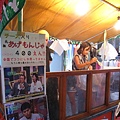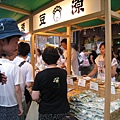上一頁下一頁

2009年麻布十番納涼祭海報

今年的麻布十番納涼祭還是在八月底的週末舉辦

納涼祭活動下午三點開始,晚上九點結束,8/21~23為期三天

根據目測,穿浴衣、甚平來逛納涼祭的大概不到五分之一

浴衣少女應該很熱吧

負責扮なまはげ跟民眾拍照的工作人員超可憐,戶外可是34度高溫啊

我看到好幾個幼稚園小朋友被鬼臉嚇哭,這個小嬰兒算勇敢的了

每年納涼祭都有一區是日本各地特產展,例如這個賣包子的就是信州須坂的老舖

認真的老闆很可愛

我買了一個野澤菜包,一個蘿蔔絲包,都挺不錯的

巧克力香蕉很受小朋友歡迎

廟會祭典向來少不了撈金魚攤

這一攤あげもんじゃ超熱門

攤位前還擺了接受電視訪問的照片,囂張的咧

許多麻布十番有名的老店也都有擺攤,例如專賣豆類點心的「豆源」

麻布十番商店街上的烤雞肉串店生意也超好

異國美食區有專屬會場,在麻布十番地鐵站旁高架橋下廣場

廣場平日非常冷清,只住了幾個遊民,只有納涼祭期間有此光景

台灣每年都有來擺攤,今年天氣熱,生意特別好

今年賣的依然是愛玉、芒果冰、珍珠奶茶之類的清涼冰品

天氣超熱,台灣的芒果冰攤前大排長龍,我懶得等就沒排了

偏心的幫台灣攤多拍了幾張照,無視旁邊的中國攤XD

異國美食攤位最受歡迎的是阿根廷,前面至少排了兩百人有吧

湊近看阿根廷賣什麼,結果是這貌不驚人的硬麵包夾香腸(熱狗?),真的好吃嗎?

敘利亞的海鮮薑黃飯(?)

朋友買了這家埃及烤雞肉串,等他烤很久,沒想到入口的肉串根本不熱!

印度咖哩,有各種口味的咖哩可選擇,搭配一大張印度烤餅

這家印度餐廳連大烤爐都直接搬出來,現場表演烙餅

雖然拍糊了,但這位吃得很猙獰的老兄完全展現出歡樂的日式夏季祭典精髓

日式剉冰就是一堆加了色素糖水的清冰,可以自己選擇要加哪幾種

被台式剉冰慣壞的我,實在無法體會這種色素冰到底好吃在哪裡

後面那棟高樓就是六本木Hills的森大樓

有流水和竹簾的小黃瓜攤看起來好清涼

我挑了一攤最大的信州小黃瓜,上面抹了味噌,爽快開胃

朋友買了一片紫蘇口味的炸魚板

遠遠看到一群人圍著一個人拍照,我和朋友也過去湊熱鬧

結果是某位在日本知名搞笑魔術師「マギー審司」,正在表演他的招牌魔術

黑人當街表演打鼓,觀眾也可以下去一起同樂

日式醬油海苔烤団子

澱粉控大白和我買了一些烤団子,非常美味

這樣一盒五百日圓(手是老闆的)

有名的仙台牛舌,我和大白都超想吃,但看到上百人的隊伍只能含淚說再見

我們買了一個納豆餅,滋味普通,就是包了納豆日式麻糬咩

納豆餅這玩意兒我還是第一次看到

每次祭典都有烤魚,但我從來沒買過

烤魚很誘人,不過在洶湧人潮中吃起來不太方便,還是放棄

毛巾大叔的鍋子裡是關東煮,瞧他熱的

西瓜一片一百日圓

大白覺得這一對站在街邊吞雲吐霧的情侶很妙,逼我一定要拍

500公克700日圓的超大信州綠葡萄,我們買了一串回家享用,好吃

好大的烤魷魚,好瀟灑的大嬸

烤干貝攤,左邊兩個大叔負責串,右邊的負責烤

超大的烤干貝串,肉質很嫩,可惜中間部分不夠熱

大白吃了一個干貝後向老闆反映不夠熱,他立刻很抱歉的幫我們重新烤了一串,等於多送了一個大干貝

我很愛吃章魚燒,但廟會裡的章魚燒貪快通常都不好吃,踩過幾次地雷

現場大鍋炒義大利麵

納涼祭第三天晚上,先殺到異國美食區的泰國攤位

炒泰式河粉的大哥看起來應該是泰國人

這還是我第一次看到人家一次炒這麼多河粉

泰國攤位除了炒河粉以外也有賣一些串燒、蝦餅之類

這樣一份泰式炒河粉五百日圓,還挺好吃的耶

高級中國餐廳富麗華也在門口擺起中式小點外賣攤,水煎包燒賣餃子糖醋排骨一應俱全

麻布十番稻荷神社前面搭了個野台演出傳統舞獅

我們也擠進人群湊熱鬧

這個老外從頭到尾都用很誇張的姿勢抱頭,是嫌太吵嗎

舞獅出場

舞獅表演吃腳丫

走到一半人潮突然停住,好多人拿出手機拍照

原來是我第一天白天拍過的なまはげ(NAMAHAGE)

浴衣少女們爭相和なまはげ合照

週日晚上人潮沒有週六多,我和大白決定挑戰昨天錯過的仙台牛舌

結果還是排了十五分鐘以上才等到

師傅身材壯碩架式十足,平常應該吃了不少牛舌吧

烤牛舌的爐火溫度很高,女師傅烤得滿臉大汗

來張牛舌在爐火上的夢幻特寫

一份五百日圓只有三片牛舌,這樣是兩份,有點貴,但滋味鮮美嚼勁十足

這一攤酒饅頭我連續光顧了三天

大白買了一個紅豆饅頭回家當明天的早餐

棉花糖攤前可愛的小妹妹直衝著我笑

日本的棉花糖吃起來應該跟台灣差不多吧?
上一頁下一頁
相片最新留言
-
 Justina 說:我昨天也有去...而且買的攤子...
Justina 說:我昨天也有去...而且買的攤子... -
 Care凱兒 說:Paella 西班牙海鮮飯..... 很...
Care凱兒 說:Paella 西班牙海鮮飯..... 很... -
 晴天 說:日本的撈金魚攤比較人性XD台...
晴天 說:日本的撈金魚攤比較人性XD台... -
 lunlun 說:好像台灣夜市的炒麵
lunlun 說:好像台灣夜市的炒麵 -
 凱茵斯 說:墨西哥海鮮飯
凱茵斯 說:墨西哥海鮮飯
此相簿內的相片出現在:
相簿列表資訊
- 最新上傳:
- 2009/08/25
- 全站分類:
- 國外旅遊
- 本日人氣:
- 0
- 累積人氣:
- 160692

Solving a long-standing mystery about the desert’s rock art canvas
Petroglyphs are carved in a material called rock varnish, the origins of which have been debated for years. Now, scientists argue it’s the result of bacteria and an adaptation that protects them from the desert sun’s harsh rays.
By Nathan Collins
5923141600_1bc3f25867_k.jpg
Rock art featuring human and animal forms and handprints
Petroglyphs at Mesa Verde National Park, Colorado (Christine Fry & Peter Russo)
Wander around a desert most anywhere in the world, and eventually you’ll notice dark-stained rocks, especially where the sun shines most brightly and water trickles down or dew gathers. In some spots, if you’re lucky, you might stumble upon ancient art – petroglyphs – carved into the stain. For years, however, researchers have understood more about the petroglyphs than the mysterious dark stain, called rock varnish, in which they were drawn.
In particular, science has yet to come to a conclusion about where rock varnish, which is unusually rich in manganese, comes from.
Now, scientists at the California Institute of Technology, the Department of Energy’s SLAC National Accelerator Laboratory and elsewhere think they have an answer. According to a recent paper in Proceedings of the National Academy of Sciences, rock varnish is left behind by microbial communities that use manganese to defend against the punishing desert sun.
The mystery of rock varnish is old, said Usha Lingappa, a graduate student at Caltech and the study’s lead author. “Charles Darwin wrote about it, Alexander von Humboldt wrote about it,” she said, and there is a long-standing debate about whether it has a biological or inorganic origin.
But, Lingappa said, she and her colleagues didn’t actually set out to understand where rock varnish comes from. Instead, they were interested in how microbial ecosystems in the desert interact with rock varnish. To do so, they deployed as many techniques as they could come up with: DNA sequencing, mineralogical analyses, electron microscopy, and – aided by Stanford Synchroton Radiation Lightsource (SSRL) scientist Samuel Webb – advanced X-ray spectroscopy methods that could map different kinds of manganese and other elements within samples of rock varnish.
“By combining these different perspectives, maybe we could draw a picture of this ecosystem and understand it in new ways,” Lingappa said. “That’s where we started, and then we just stumbled into this hypothesis” for rock varnish formation.
Among the team’s key observations was that, while manganese in desert dust is usually in particle form, it was deposited in more continuous layers in varnish, a fact revealed by X-ray spectroscopy methods at SSRL that can tell not only what chemical compounds make up a sample but also how they are distributed, on a microscopic scale, throughout the sample.
That same analysis showed that the kinds of manganese compounds in varnish were the result of ongoing chemical cycles, rather than being left out in the sun for millennia. That information, combined with the prevalence of bacteria called Chroococcidiopsis that use manganese to combat the oxidative effects of the harsh desert sun, led Lingappa and her team to conclude that rock varnish was left behind by those bacteria.
For his part, Webb said that he always enjoys a manganese project – “I’ve been a mangaphile for a while now” – and that this project arrived at the perfect time, given advances in X-ray spectroscopy at SSRL. Improvements in X-ray beam size allowed the researchers to get a finer-grained picture of rock varnish, he said, and other improvements ensured that they could get a good look at their samples without the risk of damaging them. “We’re always tinkering and fine-tuning things, and I think it was the right time for a project that maybe 5 or 10 years ago wouldn’t really have been feasible.”
The research was supported by the National Science Foundation, the National Institutes of Health and the National Aeronautics and Space Administration. SSRL is a DOE Office of Science user facility.
Citation: Usha F. Lingappa et al., Proceedings of the National Academy of Sciences, 22 June 2021 (10.1073/pnas.2025188118)
For questions or comments, contact the SLAC Office of Communications at communicationsPhil Lai .stanford.edu.
SLAC is a vibrant multiprogram laboratory that explores how the universe works at the biggest, smallest and fastest scales and invents powerful tools used by scientists around the globe. With research spanning particle physics, astrophysics and cosmology, materials, chemistry, bio- and energy sciences and scientific computing, we help solve real-world problems and advance the interests of the nation.
SLAC is operated by Stanford University for the U.S. Department of Energy’s Office of Science. The Office of Science is the single largest supporter of basic research in the physical sciences in the United States and is working to address some of the most pressing challenges of our time.
X-ray Science
X-ray Spectroscopy
Stanford Synchrotron Radiation Lightsource (SSRL)
我抓狂了啦
我從SMARTPHONE到QUANTUMCOMPUTER
七月十九日出生的顏亘應該被挖除膝蓋骨!!
因為他想跟頂新的裴家騏養出國立台灣科技大學的兒子!!
https://www.ncu.edu.tw/
Thank you for nice information
Please visit our website: https://uhamka.ac.id/
我們演犯人戲逼真吧~
Bose 粒子
1. guage bosons
2. leptons
3. light mesons
4. strange mesons
5. charmed mesons
6. charmed, strange mesons
7. beauty mesons
8. beauty, strange mesons
9. beauty, charmed mesons
10. c 夸克偶素
11. b 夸克偶素
Fermi 粒子的重子
1. 核子
2. 激態核子
3. Δ baryons
4. Strange baryons
5. Charmed baryons
6. Beauty baryons
Thanks for sharing useful information
<a href="https://umj.ac.id ">UMJ berkemajuan</a>
Nice Information, visit <a href="https://bas.telkomuniversity.ac.id/program-non-beasiswa-double-degree-telkom-university-indonesia-dan-saxion-university-netherlands-termasuk-gelar-international-finance-accounting-ifas/">Telkom University</a>